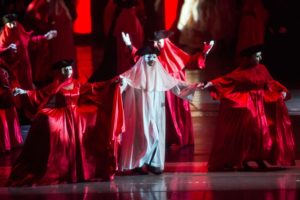
Deutsche Oper Berlin 2017-18 Review – Un Ballo in Maschera: Anja Harteros Shines Brightest At The Ball
By Lois SilversteinThe scene is set: a masked ball, set into the morning audience of King Gustavo III of Sweden – scarlet taffeta capes and gowns, coal-black hats and boots, creme and black masks. Donald Runnicles’, Music Director of the Deutscher Oper Berlin, lifts his baton with the brisk and lively overture to Verdi’s “Un Ballo In Maschera” and the curtain rises. Gótz Friederich’s production promises vitality and originality. And sure enough, lights, movable and adaptable sets, created by Gottfried Pilz and Isabel Ines Glather savor the very first moments, especially as the lustrous cast, headed by German soprano, Anja Harteros, takes its places.
It was more than a treat.
Shifting Realities
Verdi’s opera, 1857, is not performed as frequently as “Rigoletto” or “La Traviata,” but shares much of the élan of these two. Its music weaves together the dramatic and comic elements as it moves from melodrama to lighter modes. It soars and pops, fugal motifs in the orchestra and the chorus, accent the shifts, while pure melody enriches the unfolding story and its fantastical elements that keep shifting the perspective throughout. Verdi’s orchestral coloration is broad too, juxtaposing solo brass and flute then adding harp, for instance. It recalls bel canto moments here, illustrating how Verdi looked back as well as forward as he proceeded. Shifts like this fit well with what Friedrich aimed for as he blended blithe and moody elements of the libretto into the stage business along with the music. Runnicles’ kept the orchestra dynamic and in pace with it all. While singers and dancers moved in and around the varying empty panels in orderly zig-zag, their music further underscored the narrative momentum. Verdi’s score works the music, however, so it alternates between flights of fancy and the very real threat of assassination. Gustav first plays games on stage with a dollhouse; this could be construed as the palace itself if the whole is seen in its philosophical dimension as suggested by the production. Yet, the actual gunshot, the blood on the clown costume Gustaf wears as he pardons all involved in the plot, make short shrift of philosophy or fantasy. The whole is welded on the multiple levels Verdi invested in the opera from the start.
The Star of the Night
Anja Harteros sang Amelia with more than mastery: at moments, she touched the sublime. From her first scene with Ulrica, Harteros freely engaged her wide range of expression and extraordinary vocal range, with her low notes more than audible and her top register moving with substance every note of the way. Never did we feel strain. She hit every note with integrity, each getting its own due and contributes to the legato without seam. “Morro, ma prima in grazie” brought shivers of delight as well as singing with conviction. Never did she stray from her character. Always she invested herself in the torn loyal wife and the yearning beloved she might have betrayed him for. Embodied she was, Amelia, the wife of Rene, Amelia the beloved of Gustavo. Furthermore, she invested herself in the additional dimension of the flirty, kittenish and playful beloved, for a few moments, free from her dilemma, and able to act out some of the love she felt for the king. It was so satisfying to see her play around the tree and bob her head and grin with delight.
Bookends To the Real Jewel In the Crown
Other major singers, tenor Dmytro Popov, Baritone Luca Salsi contributed their share of ardor and high seriousness, though without the depth of Harteros. With beautiful high notes, Popov’s voice soared in his arias and his duet with Amelia; then he seemed more relaxed and out of physical constraint. Overall, however, his performance did not match Harteros’ passion and commitment So too with Salsi. “Eri tu Che maccchiava l’anima,” featured Salsi’s hefty baritone, and he attacked his role and its vital arias with gusto. However, his conviction seemed applied rather than embodied. In a way, he matched Gustavo, his friend, with the two book-ending the real jewel in the crown, the woman they both loved.
Soprano Heidi Stober, as Oscar, was excellent. She was a true Puck, darting around the stage while singing and smiling and conning and coining a fresh thread among the others. She did the job the libretto asked for and more, mainly because her presence on the stage kept us aware of the structural cohesion. She sustained the narrative in the first act by convincing Gustavo not to banish Ulrica, and then in the final act by providing the clue to Gustavo’s disguise. Her voice reached high amplitude, and she came across as cherished.
Ulrica, played by contralto Judih Kutasi, did a righteous job, her unibrowed facial make-up and her somewhat cliched costume and stage behavior, notwithstanding.
Clearly, Verdi was mixing and matching in “Ballo,” and in this Berlin performance, his success shows. The production did sustain the ontological reality for which it aimed. Using the Scribe version of the libretto, set in Sweden rather than the Boston setting, helped too. Appearance and reality here work better with an actual historical reality than otherwise. the whole production a phosphorescence that combines with the play within a play structure with its useful parabolic effect. As we walk out on Richard-Wagner Strasse 10 under the Berlin sky, we ask ourselves that very thing. Appearance and reality – what counts. What is real and what is not. We too, like Gustavo, who dies in his Pierrot costume, must live and let go. The curtain comes down and we go back to our daily lives.


